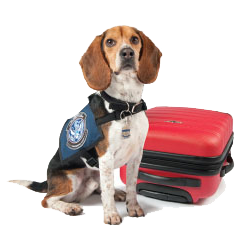International Traveler: Milk, Dairy, and Egg Products
[ Back ]
The United States restricts or prohibits the entry of many agricultural products, which can carry foreign pests and diseases that harm American agriculture and our environment. A major pest or disease outbreak could mean higher grocery bills, shortages of certain foods, and devastating losses for our farmers and ranchers. Help us keep American agriculture healthy by following the guidance on this page about products you may want to bring into the United States.

Are you traveling from Canada by Land? Find out which meat, poultry and pet food products that you CAN and CANNOT bring back to the U.S. from Canada's land border. Air travelers should refer to the guidance listed below.
Milk, Dairy, and Egg Products that you CAN and CANNOT bring back to the U.S. from other countries (choose below)
- Milk and Dairy Products
-
Most milk and dairy items from countries with foot-and-mouth disease (FMD) are not allowed. To find out a country’s status for FMD, visit our animal disease status page.
There are three exceptions:
- Liquid milk and milk products for infants or small children are allowed in small quantities (enough for several days’ use)
- Products containing powdered or dry milk (baby/infant formula, baking mixes, soup mixes, drink mixes) are allowed in small quantities, if they are properly labelled.
- Commercially-packaged and labelled, cooked, shelf-stable, fully finished food items in unopened packages are allowed.
Travelers may bring back milk or dairy products from countries without FMD if they have official documentation to prove the product’s country of origin. The following items are considered official documentation: package label; written documentation; proof of travel (passport or travel itinerary); origin of flight; receipt of sale; CBP document (based on the officer’s interview of the traveler); a meat inspection certificate; or certificate of origin.
Exemptions
Certain items may enter from any country. These include:
- Butter
- Butter oil
- Solid hard or soft cheeses (as long as the cheese does not contain meat or pour like a liquid i.e. ricotta or cottage cheese)
Camel Milk
Please contact us directly regarding the requirements for camel’s milk.
Breast Milk
USDA does not regulate breast milk. Please contact the Food and Drug Administration at 301- 796-0356 or www.fda.gov for more information.
- Eggs and Egg Products
-
USDA does not allow travelers to bring back most eggs or egg products from countries affected with certain serious poultry diseases:
- Highly pathogenic avian influenza
- Virulent Newcastle disease
To find out a country’s status for these diseases, visit our animal disease status page.
There are two exceptions:
- Commercially-packaged and labelled, cooked, shelf-stable, fully finished food items from affected countries that are in unopened packages are allowed.
- Cooked eggs or egg products from affected countries will be inspected by U.S. Customs & Border Protection. Items appearing to be “thoroughly cooked throughout” will be allowed entry. Items that do not appear “thoroughly cooked throughout” will not be allowed without special certification and an import permit.
Travelers may bring back fresh or preserved eggs from countries without these diseases if they have official documentation to prove the product’s country of origin. The following items are considered official documentation: package label; written documentation; proof of travel (passport or travel itinerary); origin of flight; receipt of sale; CBP document (based on the officer’s interview of the traveler); a meat inspection certificate; or certificate of origin.
Egg Shells
Egg shells (with egg white and egg yolk removed) may enter in passenger baggage if they are decorated/etched/painted. They must be clean and dry, and passengers may not bring back more than 12 per person.
Moon Cakes
There are specific requirements for moon cakes entering in passenger baggage:
- Moon cakes that do not contain meat, egg or egg yolk may enter.
- Moon cakes containing egg or egg yolk that appear “thoroughly cooked throughout” are allowed.
- Moon cakes containing egg or egg yolk that do not appear “thoroughly cooked throughout” are not allowed.
- Moon cakes that contain meat are not allowed.
How Do I Declare Agricultural Items?

USDA-trained dogs help sniff out plants and animal products in luggage and carry-on items on international flights. Make sure you include any agricultural items on your Customs Declaration Form (select form below). This form provides Customs and Border Protection officials with basic information about who you are and what you are bringing into the United States, such as agricultural and wildlife products and whether you have visited a farm prior to traveling to the United States. When you declare, a U.S. Customs and Border Protection official can check your items. This is the only way to be certain that your items are free of plant pests and animal diseases.
Customs and Border Protection (CBP) Forms